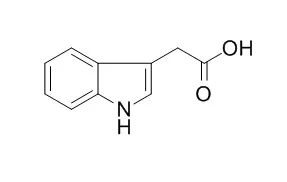| In vitro: |
| FEMS Microbiol Rev. 2007 Jul;31(4):425-48. | | Indole-3-acetic acid in microbial and microorganism-plant signaling.[Pubmed: 17509086 ] | Diverse bacterial species possess the ability to produce the auxin phytohormone Indole-3-acetic acid (IAA).
METHODS AND RESULTS:
Different biosynthesis pathways have been identified and redundancy for IAA biosynthesis is widespread among plant-associated bacteria. Interactions between IAA-producing bacteria and plants lead to diverse outcomes on the plant side, varying from pathogenesis to phyto-stimulation. Reviewing the role of bacterial IAA in different microorganism-plant interactions highlights the fact that bacteria use this phytohormone to interact with plants as part of their colonization strategy, including phyto-stimulation and circumvention of basal plant defense mechanisms. Moreover, several recent reports indicate that IAA can also be a signaling molecule in bacteria and therefore can have a direct effect on bacterial physiology.
CONCLUSIONS:
This review discusses past and recent data, and emerging views on IAA, a well-known phytohormone, as a microbial metabolic and signaling molecule. | | Plant Cell. 2005 Feb;17(2):616-27. Epub 2005 Jan 19. | | Characterization of an Arabidopsis enzyme family that conjugates amino acids to indole-3-acetic acid.[Pubmed: 15659623 ] | Substantial evidence indicates that amino acid conjugates of Indole-3-acetic acid (IAA) function in auxin homeostasis, yet the plant enzymes involved in their biosynthesis have not been identified.
METHODS AND RESULTS:
We tested whether several Arabidopsis thaliana enzymes that are related to the auxin-induced soybean (Glycine max) GH3 gene product synthesize IAA-amino acid conjugates. In vitro reactions with six recombinant GH3 enzymes produced IAA conjugates with several amino acids, based on thin layer chromatography. The identity of the Ala, Asp, Phe, and Trp conjugates was verified by gas chromatography-mass spectrometry. Insertional mutations in GH3.1, GH3.2, GH3.5, and GH3.17 resulted in modestly increased sensitivity to IAA in seedling root. Overexpression of GH3.6 in the activation-tagged mutant dfl1-D did not significantly alter IAA level but resulted in 3.2- and 4.5-fold more IAA-Asp than in wild-type seedlings and mature leaves, respectively. In addition to IAA, dfl1-D was less sensitive to indole-3-butyric acid and naphthaleneacetic acid, consistent with the fact that GH3.6 was active on each of these auxins. By contrast, GH3.6 and the other five enzymes tested were inactive on halogenated auxins, and dfl1-D was not resistant to these.
CONCLUSIONS:
This evidence establishes that several GH3 genes encode IAA-amido synthetases, which help to maintain auxin homeostasis by conjugating excess IAA to amino acids. | | The Plant Journal, 2005, 3(5):681-689. | | Indole‐3‐acetic acid homeostasis in transgenic tobacco plants expressing the Agrobacterium rhizogenes rolB gene[Reference: WebLink] | The rolB gene of the plant pathogen Agrobacterium rhizogenes has an important role in the establishment of hairy root disease in infected plant tissues. When expressed as a single gene in transgenic plants the RolB protein gives rise to effects indicative of increased auxin activity. It has been reported that the RolB product is a β-glucosidase and proposed that the physiological and developmental alterations in transgenic plants expressing the rolB gene are the result of this enzyme hydrolysing bound auxins, in particular (indole-3-acetyl)-β-D-glucoside (IAGluc), and thereby bringing about an increase in the intracellular concentration of Indole-3-acetic acid (IAA).
METHODS AND RESULTS:
Using tobacco plants as a test system, this proposal has been investigated in detail. Comparisons have been made between the RolB phenotype and that of IaaM/iaaH transformed plants overproducing IAA. In addition, the levels of IAA and IAA amide and IAA ester conjugates were determined in wild-type and transgenic 35S-rolB tobacco plants and metabolic studies were carried out with [13C6]IAA [2′-14C]IAA, [14C]IAGluc, [5-3H]-2-o-(indole-3-acetyl)-myo-inositol and [14C]indole-3-acetylaspartic acid. The data obtained demonstrate that expression of the rolB encoded protein in transgenic tobacco does not produce a phenotype that resembles that of IAA over producing plants, does not alter the size of the free IAA pool, has no significant effect on the rate of IAA metabolism, and, by implication, appears not to influence the overall rate of IAA biosynthesis. Furthermore, the in vivo hydrolysis of IAGluc, and that of the other IAA conjugates that were tested, is not affected.
CONCLUSIONS:
On the basis of these findings, it is concluded that the RolB phenotype is not the consequence of an increase in the size of the free IAA pool mediated by an enhanced rate of hydrolysis of IAA conjugates. |
|






 Cell. 2018 Jan 11;172(1-2):249-261.e12. doi: 10.1016/j.cell.2017.12.019.IF=36.216(2019)
Cell. 2018 Jan 11;172(1-2):249-261.e12. doi: 10.1016/j.cell.2017.12.019.IF=36.216(2019) Cell Metab. 2020 Mar 3;31(3):534-548.e5. doi: 10.1016/j.cmet.2020.01.002.IF=22.415(2019)
Cell Metab. 2020 Mar 3;31(3):534-548.e5. doi: 10.1016/j.cmet.2020.01.002.IF=22.415(2019) Mol Cell. 2017 Nov 16;68(4):673-685.e6. doi: 10.1016/j.molcel.2017.10.022.IF=14.548(2019)
Mol Cell. 2017 Nov 16;68(4):673-685.e6. doi: 10.1016/j.molcel.2017.10.022.IF=14.548(2019)